|
Fairey Gannet ASW
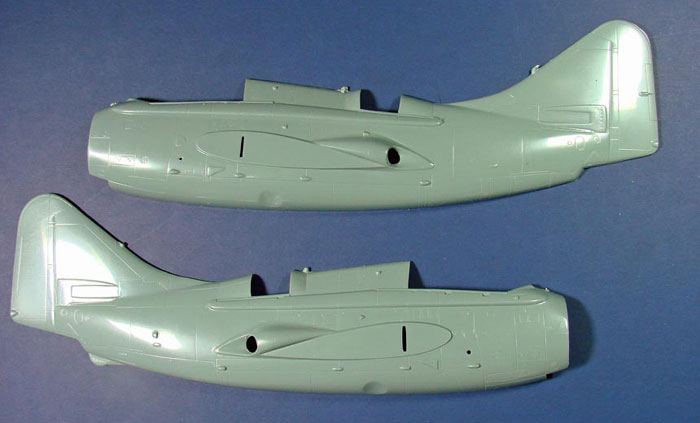
Classic Airframes, 1/48
scale
S
u m m a r y
|
| Catalogue Number: |
4135 - Fairey Gannet ASW |
| Scale: |
1/48 |
| Contents and Media: |
56 parts in blue-gray styrene, 29 parts in gray
colored resin and 7 clear injection molded parts. Instructions, decal
sheet and painting guide for 4 aircraft. |
| Price: |
MSRP
USD$65.00 |
| Review Type: |
FirstLook |
| Advantages: |
Crisply engraved and excellent surface detail;
first injection molded Gannet in 1/48; separately packed clear parts;
decals for four different naval air forces. |
| Disadvantages: |
Some modeling experience is always helpful. Some
clear parts knocked off the sprue in shipment, but without any damage. |
| Recommendation: |
Highly Recommended |
Reviewed by
Steven "Modeldad" Eisenman

Classic
Airframes' 1/48 scale Fairey Gannet will be available online from Squadron
If ever there was a nation that was painfully aware
of the effect of submarine warfare, it was Great Britain. Near the end
of the Second World War, it was clearly recognized that a dedicated
anti-submarine warfare aircraft was needed, and the Fairey Firefly was
just not going to be able to fulfill that role.
Specification GR. 175/45 was put out at the end of
1945 for a dedicated anti-submarine warfare aircraft that was also
capable of anti-shipping capabilities. Gr. 175/45 was also grounded in
a technology that had been previously developed by Fairey, that was the
use two engines, each with its own crankshaft to power co-axially
mounted, contra-rotating props. This had great advantage for carrier
based aircraft in that there was the safety of two engines, rather than
one; the engines could be mounted in the fuselage, rather than enlarging
the wings to accommodate two propulsion units; and contra-rotating props
eliminated the effect of propeller torque. Another advantage of such an
arrangement was that one engine could be shut down to conserve fuel and
extend flight time, an important factor in long-range anti-submarine
patrols. With the improvements in turbo-engine design, the Armstrong
Siddeley Mamba engine became the power plant of choice. When Fairey
coupled two together for its proposed Type Q (the Gannet) it became know
as the “Double Mamba”.
Development of the Type Q began in 1946, but it was
not until 19 June 1950 that the first Type Q actually engaged in flight
deck trials on HMS Illustrious. On that date, the Type Q became the
first turbo-prop aircraft to takeoff and land on an aircraft carrier.
Nearly another three years would go by until the first production Gannet
AS. 1 made it debut in June 1953 and two more years until the gannet
entered operational unit service with 826 Squadron in January 1955.
The AS. 1 Gannet had a crew of three, pilot,
observer and rearward facing radar operator. Its offensive weapons were
carried in the weapons bay, which could accommodate various combinations
of torpedoes, depth charges, sea mines, conventional high-explosive
bombs and sonobouys. Four mounting points under the center section of
each wing could be used for up to 24 unguided rockets.
The Classic Airframes Gannet ASW – AS.1 / AS.4 is
the first primarily injected molded Gannet in 1/48 scale. It is a
valuable addition to the growing number of Fleet Air Arm aircraft of the
early Post-Second World War / Cold War period.
The injection molding is of the same smooth plastic
as was used in the Wyvern. The engraved detail is quite crisp and fine,
but will not be lost under a coat of paint. There is virtually no flash
on the parts. Clean up should be very quick.
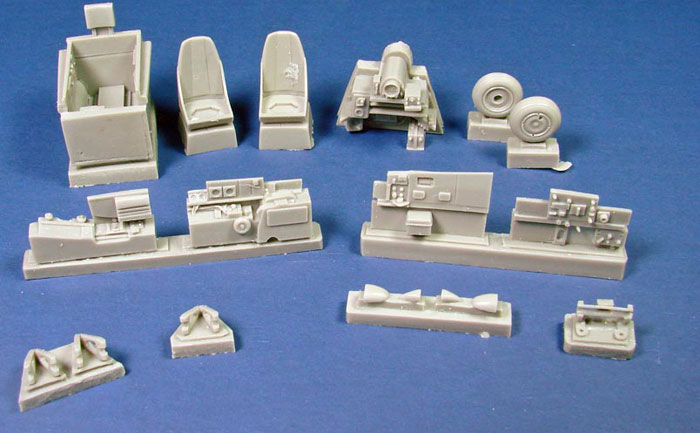
Click
the thumbnails below to view larger images:
[../../../photogallery/photo00020327/real.htm]
As for the smooth nature of the plastic itself,
this is due to the molds being highly polished. In the case of the
Wyvern, I found the smooth surface did not affect paint adhesion.
Some modelers may find the surface an advantage in that less time is
spent getting a smooth surface for that perfect finish.
Interestingly, while the kit is designated as an
AS. 1 / AS. 4, the fuselage is molded as an AS. 4. However, the actual
external difference between the 1 and the 4, for all intents and
purposes, is merely the absence of two small portholes on each side of
the AS. 4 aircraft, just in front of the radar operator’s cockpit. But,
it also seems that many AS. 1 aircraft had the portholes blanked out
because of the glare that affected the radar screen. If one wanted to
do an early AS. 1, merely drill out the portholes and fill with Crystal
Clear. The location of the portholes can be seen on the paining guide.
The AS.4, basically, was the AS.1 with a more powerful engine.
The wings are also nicely detailed. For some
modelers, a light sanding of the trailing edge may be wanted to thin it
a bit. Even though the kit does not come with rocket rails, the
underside of the wings have the attachment points clearly marked, so
attaching after-market rails will not present a problem as to their
location. The question is whether anyone will do an aftermarket
wing-fold set.
The resin pieces are nicely molded and provide for
good cockpit detail. The radar operator’s cockpit is molded as a single
tub. There appears to be only one potentially problematic pour block to
contend with; that is resin part 11, the nose piece. This piece may
best be dealt with by sanding down the back surface on course sandpaper
on a hard flat backing, such as glass, until it fits on the front of the
fuselage. The wheel well pieces present the usual problem of removing a
pour block on top and sanding the well to fit within the wings.
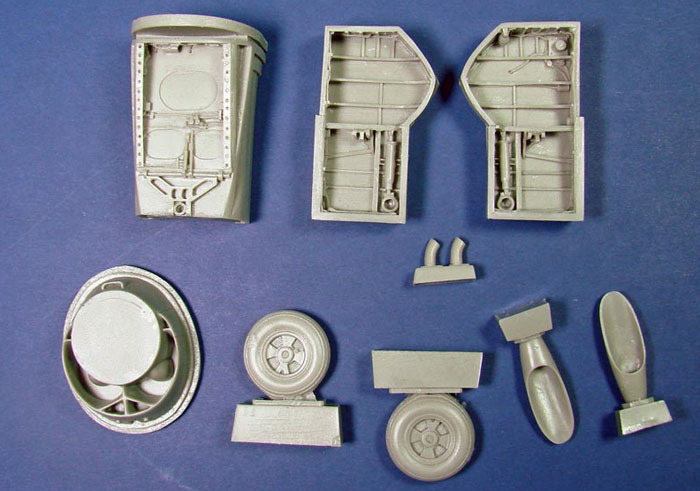
Considering that one of the initial problems of the
Type Q / Gannet was that it was a tail sitter, it looks like the kit
will not be much different. The kit appears to allow for good room in
which to add nose weight. In fact, the top of the nose gear housing is
concave and appears perfectly designed to accept a fair amount of BB’s
or lead fishing weights
The clear parts clearly would benefit from a
dipping in Future. It would also appear that the canopies in this kit
are a modeling anomalie. At least the one over the radar operator’s
cockpit is; for it sits quite nicely in the open position. The
observer’s canopy also seems to fit well open, with a need to hold it in
position as the glue sets.
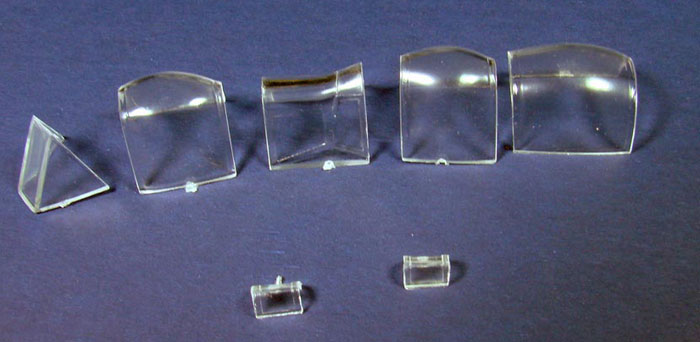
Construction of this kit is quite straight forward
and does not appear to be overly complex. Assembly begins with the
cockpits creating the two main tubs. The back of the main cockpit
creates a wing spar.
I would take issue with step 4. Attaching the nose
gear at this early stage creates an invitation to a snap-off disaster.
As with most modeling projects, putting on of the gear would be a
something I would do as a final step.
One of the big complaints about the Wyvern was that
the propeller blades were set in the aligned position, unless one did
some cutting. In the Gannet the fore and aft propeller units are
separate and can be positioned as you want them.
Markings
There are markings for the aircraft of four
different nations. As for the color/colour scheme, all are in basic
Extra Dark Sea Grey over Sky.
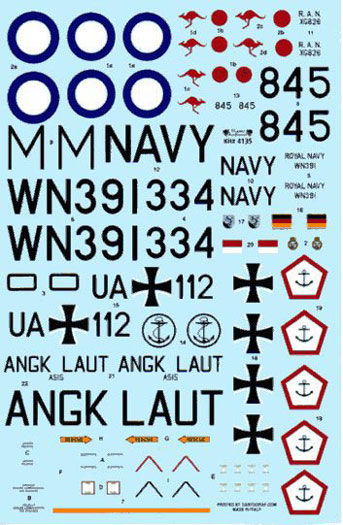
[../../../photogallery/photo00029807/real.htm]
-
824 Squadron, HMS
Ark Royal, Circa 1956. This unit replaced its AS.1s with the AS. 4
by October 1956 and was the first unit to receive the AS.4
-
816 Squadron, Royal
Australian Navy, HMAS Melbourne, circa mid-1960s. The RAN operated
the AS.1, which were delivered in 1956. The AS.1 portholes were
most likely blanked out.
-
MFG 3 (Marinefliegergeschwader)
Federal German Navy, circa 1980s (This appears to be a misprint and
should read 1960s). This aircraft is an AS.4 originally assigned to
MFG 1. When MFG 1 was placed under MFG 3 control, the aircraft
retained their MFG 1 code of “UA”.
-
Indonesian Navy,
Circa 1962. This aircraft is an AS.4. The serial number as printed
is not correct. The decal has the serial number printed as A515, it
should be AS 15, and there should be a space or dash between the AS
and the 15.
I have not and cannot comment on the accuracy of
this kit. There are drawing in the Warpaint monograph, but questions
have been raised about them, so I did not use them for reference
purposes. I do not have the +4 volume. I also have never seen one in
the “metal”. However, the pieces seem to capture well the outline and
appearance of the aircraft, as ugly as that is, as the aircraft appears
in numerous photographs. Comments are, of course, welcomed.
I may be wrong, and could wind up eating my words,
but I get the impression that this just could just be a “shake and bake”
limited run kit (is that an oxymoron?). Of course care must be taken,
as there are no locating pins with which parts are aligned.
Regardless of what may follow, the Classic
Airframes Gannet appears to be an excellent kit.
I am currently finishing up the CA Seahawk (
surprisingly a relatively easy build) and I welcome the addition of the
Gannet to sit alongside the Seahwk and Wyvern. It may look dumpy and
even a bit odd with those seemingly undersized propellers, but this kit
allows me to continue my love affair with ugly aircraft.
Highly Recommended.
Reference:
Warpaint Series No. 23; Fairey Gannet; by Steve Hazel; Hall
Park Books.
Thanks to
Classic Airframes for
the review sample.
Classic Airframes
kits are available worldwide through hobby retailers and from
Squadron.com
Review and Images Copyright © 2007 by Steven "Modeldad"
Eisenman
Page Created 22 August, 2007
Last updated 24 December, 2007
Back to HyperScale Main Page
Back to Reviews Page
|
Home
| What's New |
Features |
Gallery |
Reviews |
Reference |
Forum |